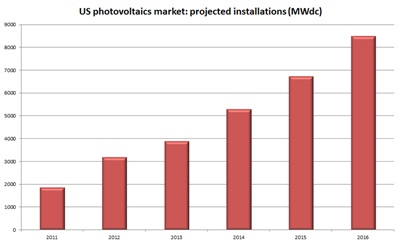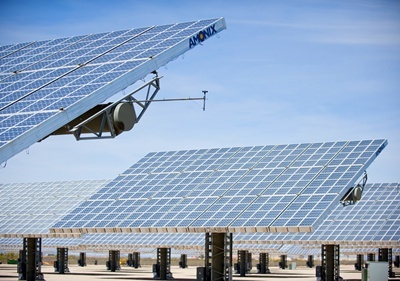
The US witnessed a major increase in deployments of large-scale solar photovoltaics in the second quarter of 2012, according to a new report.
Produced by the Solar Energy Industries Association (SEIA) industry group awhich opposed the recent implementation of import tariffs on Chinese-made solar products in the country ain collaboration with analysts at Greentech Media (GTM Research), the report states that a total 742MW of PV was installed in Q2.
That figure represents a 45% upturn on the first quarter of the year and is more than double the amount recorded during Q2 of 2011.
Although the rate of growth is likely to slow in in the remainder of the year, the report still predicts that 3.2GW will be deployed across the US in total in 2012 a representing a year-on-year increase of 71% and contributing to the diversification of the global PV market away from its historic reliance on Europe, and Germany and Italy in particular.
Much of the recent growth relates to a spike in utility-scale deployments, with the report stressing that the various sub-markets within the US are showing very different dynamics.
Different market dynamics
The residential market, for example, grew only incrementally in Q2 aand actually shrunk in the key markets of New Jersey and sunny Arizona. Levels of what the report describes as anon-residentialainstallations (relatively small-scale commercial deployments) even fell from the opening quarter of 2012.
But in stark contrast close to 450MW were deployed as part of utility-scale projects in Q2, thus accounting for just over 60% of the entire US market. Among the utility projects to come online was the Cogentrix 30MW (peak) concentrating photovoltaics (CPV) facility in Alamosa, Colorado. It represents the largest CPV project yet deployed, and features panels manufactured by the US company Amonix.
The utility market in the US relies heavily on a number of particularly large projects, for example the 290MW Agua Caliente facility in Arizona, which is powered by CdTe panels from First Solar, and the 150MW initial phase of the Mesquite Solar project, also in Arizona, which uses Suntech Power modules. In July, First Solar said that it had completed 200MW of the Agua Caliente facility, which is currently the world's largest operating PV plant.
 CPV by Amonix
CPV by Amonix
Despite the uncertainty being caused by the US presidential election a in which renewable resources and the desire for energy independence have become key issues a as well as the potential expiration of tax credits for PV installations later in the decade, the SEIA/GTM report forecasts solid growth for the US market through 2016.
It suggests that annual US installations will grow to 3.9GW next year (equivalent to a 22% increase over the 2012 projection), and rise to some 8.5GW in 2016. Of that 2016 total, around 4.5GW is predicted to result from utility projects, along with 2.5GW of anon-residentiala installations and 1.5GW from residential installations.
Tariffs fail to impact pricing
The price of PV also continued to drop sharply in the US during Q2. According to the SEIA/GTM figures, the national average price for residential system installation fell 6% sequentially to $5.46per Watt.
A Non-residentiala installations cost an average $4.38per Watt in Q2, down 14% year-on-year, while utility projects showed a much steeper price decrease. At $2.60per Watt in Q2, these were down 33% on the previous year a partly a result of major deployments by vertically integrated project developers, and partly reflecting the use of low-cost Chinese PV modules.
The report adds that anti-dumping tariffs on cheap imports containing Chinese-made cells has had little impact on prices, even though in some cases it has resulted in a re-routing of products through Taiwan at a slight cost penalty.
This increase does not prohibit China-based suppliers from continuing to provide relatively low-priced modules to US developers, it states. aCoupled with further conversion cost reductions and the continuing decline in average selling prices, a significant increase in US pricing some in the industry had expected has not materialized.
Full details of the new SEIA/GTM Research report on the US photovoltaics market are available via via slideshare.net.





